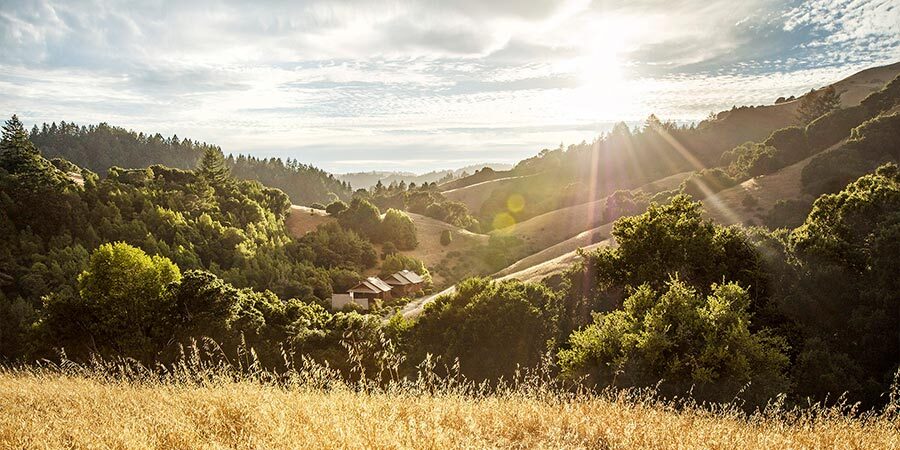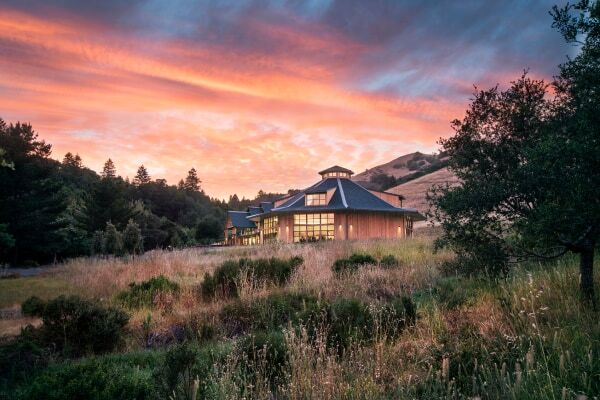Spirit Rock is located in the San Geronimo valley of West Marin County, California on unceded Coast Miwok territory. We name the history of this beloved place as a gesture of respect and reparation toward the Indigenous residents of the colonized land we now call home. We honor the Coast Miwok peoples, including the Federated Indians of Graton Rancheria and the Coast Miwok Tribal Council of Marin, who have brought a Ceremony to Spirit Rock to celebrate and honor the land and its history.
We commit to creating a culture of honor. We respect the enduring relationship between Coast Miwok and Indigenous peoples and their traditional territories. We strive to be good guests of the Coast Miwok people.
Local Tribal Groups
The Indigenous people local to West Marin are the Coast Miwok, part of the Me-Wuk language group.
The Miwok are represented by cultural and political groups including the Coast Miwok Tribal Council of Marin, who have brought Ceremony to Spirit Rock celebrating and honoring the land and its history. The registered tribal nation for the Coast Miwok and some Pomo is the Federated Indians of Graton Ranchería (FIGR), in Rohnert Park.
Other local tribal groups include:
San Francisco: Ramaytush Ohlone
East Bay: Lisjan/Chochenyo Ohlone
South Bay: Muwekma Ohlone
Sonoma: Southern Pomo of Dry Creek Ranchería & Cloverdale Ranchería
A Brief History of the Spirit Rock Land
The area of West Marin that is now home to Spirit Rock has been inhabited by the Coast Miwok and related communities for at least two millennia. Many North American tribes have records of their history as far back as the time of the Buddha (500 BCE), and evidence has been found of human habitation in California 13,000 years ago.
The Miwok people’s first contact with Europeans was with English explorer Sir Francis Drake in 1579. Colonization of the Bay Area began with the Jesuit priest Junipero Serra establishing the Mission system in 1769, and the Spanish occupying “Alta California” as part of Mexico. The Missions held Indigenous Californians in near-slavery as forced laborers until Mission land was broken up into land grants in 1834.
Most of West Marin was part of the Nicasio land grant, given to the “San Rafael Christian Indians” but quickly broken up into private tracts by non-Indigenous settlers. Then, following the 1848 US conquest of Mexico and annexation of California, the US pursued a war of extermination against California’s Indigenous people. The “California Genocide” killed 95% of the state’s remaining Indigenous people by 1880.
In 1920, the Coast Miwok and Southern Pomo nations were consolidated under the name “Graton Ranchería,” becoming a federally-recognized tribe until 1958, when the federal government disbanded all of California’s rancherías (reservations) and privatized their land. Following a campaign by the tribe, federal recognition of Graton Ranchería was restored in 1997. Separately, the Coast Miwok Tribal Council of Marin is organized under the 1975 Indian Self-Determination and Education Assistance Act.
By the 1980s, the Nature Conservancy owned the land that would become Spirit Rock. Following several years of organizing retreats on the west coast, a group including Jack Kornfield, Sylvia Boorstein, Anna Douglas, Howard Cohn, James Baraz, and members of several Bay Area meditation groups purchased the 411-acre parcel from the Nature Conservancy with an agreement to leave it largely undeveloped outside the main campus area. Spirit Rock has developed a friendship with the Coast Miwok Tribal Council of Marin, and we have begun what we hope is a long, fruitful interwoven relationship with Indigenous communities locally and beyond.

Background: What is a land acknowledgment?
A land acknowledgment is a spoken or written statement that names and honors the ancestral people associated with the land where the speaker now lives or works. The practice of land acknowledgment has arisen in recent years as a gesture of respect and reparation toward the ancestral and contemporary Indigenous residents of colonized lands such as North America (called “Turtle Island” by many Indigenous cultures).
Many land acknowledgments, such as this one, also connect readers to educational materials about the history of the land, its human and non-human residents, and actions that can be taken to offer reparations or other forms of support to local Indigenous organizations.
Why do one?
The purpose of doing land acknowledgments is to break the cycle of delusion and ignorance about Indigenous displacement and genocide. At Spirit Rock, educating ourselves about the conditions that have shaped our world is part of how we understand the Buddha’s instructions to investigate the root causes of suffering, and to act with the intention to prevent harm in the future.
At the heart of American history are the formative conditions of Native genocide and African slavery, which continue to define our cultural landscape. The United States is not a nation of immigrants, as is commonly taught, but originally was a nation of settler colonists, refugees, and slaves. The term “settler colonist” brings into the foreground the violence of European settlement in lands that were already occupied, tended for thousands of years by stable, thriving Indigenous nations. This is true for all of the North and South American continents, as well as Australia, South Africa, and other places where colonial Europeans not only occupied and governed existing nations but actively displaced the residents, creating new European colonies.
In the context of this painful history, the practice of land acknowledgment can be thought of as a form of cultural mindfulness, bringing awareness and compassion to the present by understanding the conditions we inherit from the past. Land acknowledgments are educational, and also have a ritual function: they can invoke ancestors, ask forgiveness, offer reparations, and invite a deepening in self-awareness for people descended from settlers.
Further resources on the practice of land acknowledgment are offered below.
Resources for further study
Find which Indigenous people lived where using the Native Land interactive map.
About land acknowledgment
Native Governance Center, A Guide to Indigenous Land Acknowledgment
US Dept. of Arts & Culture, #HonorNativeLand: A Guide and Call for Acknowledgment
LWVWI Community Alliances Committee, Land Acknowledgement Guide
California Indian Culture
Inter-Tribal Council Of California (ITCC)
CA Native American Heritage Commission, California Indian History
CA Indian Museum, California Native Perspectives
Federated Indians of Graton Ranchería (FIGR), Historical Background & Timeline
Map of Indigenous American Cultures & Living Histories, Federated Graton Ranchería
UC Berkeley, California Indian Songs and Stories
KQED, How This Native American Elder Reclaimed Sacred Land in the Bay Area
North American Indian Culture
National Congress of American Indians (NCAI)
History: The California Genocide
Madley, “It’s time to acknowledge the genocide of California’s Indians” (LA Times)
“Newsom apologizes for California’s history of violence against Native Americans” (LA Times)
Madley, “The Hidden History of How California Was Built on Genocide” (Truthout)
History: Treaties
OPB, Broken Treaties [documentary]
Unsettling, Decolonization, Allyship, Solidarity
Sogorea Te’ Land Trust, Recommended Reading
Resource Generation, Land Reparations & Indigenous Solidarity Toolkit
Taking action
There are many ways to take action to support Indigenous cultures and their rights. Donations can be made directly to many tribes, and Native-led cultural and economic projects like those produced by the Coast Miwok Tribal Council of Marin can be supported.
One powerful Indigenous-led project here in the Bay Area is the Sogorea Te’ Land Trust, facilitating the restoration of a land base for the Ohlone people in the East Bay through a voluntary “land tax” paid by individuals and groups living and working in the East Bay. If you live or work in the East Bay, please consider paying the Shuumi Land Tax to Sogorea Te’. Residents of Humboldt county can pay a similar honor tax to the Wiyot tribe there.


